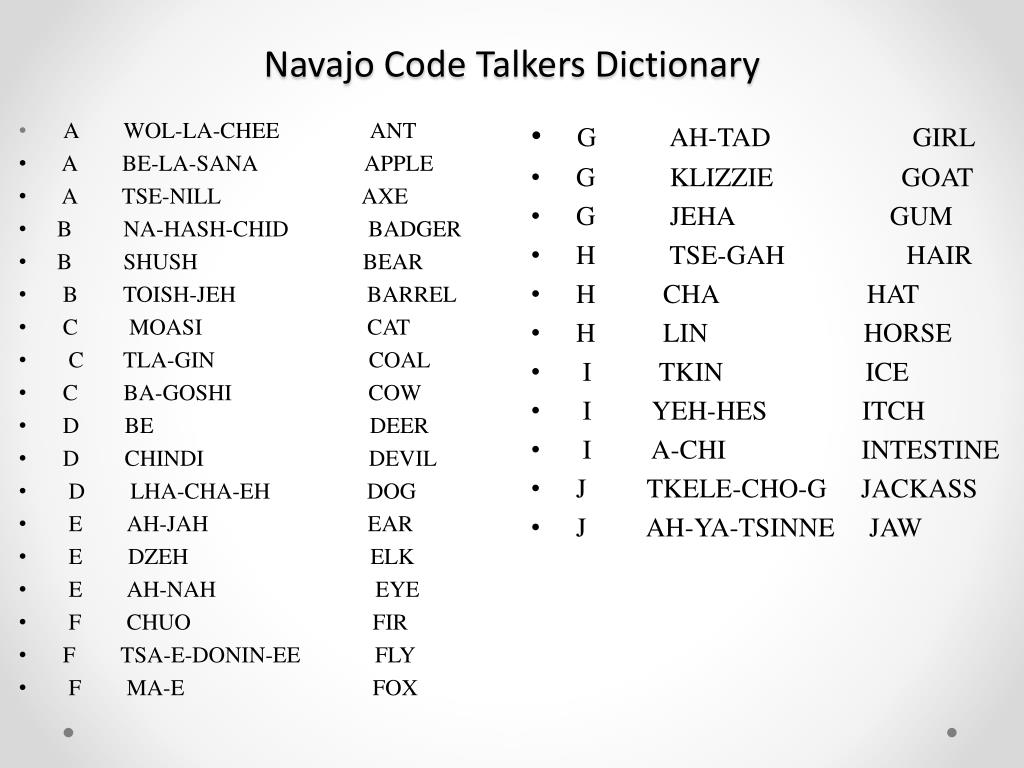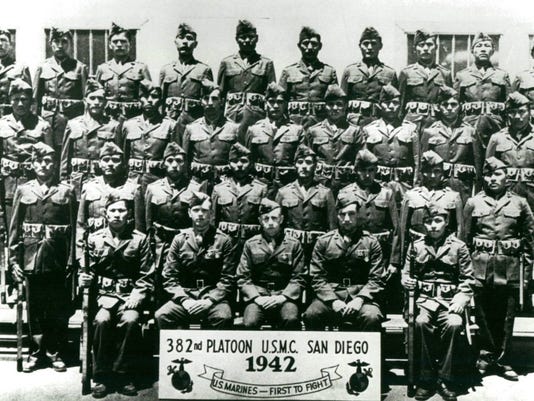
Philip Johnston. accentonlanguages.com

A small example of the Navajo code. slideserve.com
𝙽𝙰𝚅𝙰𝙹𝙾 𝙲𝙾𝙳𝙴 𝚃𝙰𝙻𝙺𝙴𝚁𝚂: 𝙼𝙰𝙺𝙸𝙽𝙶 𝙰𝙽𝙳 𝙱𝚁𝙴𝙰𝙺𝙸𝙽𝙶 𝙱𝙰𝚁𝚁𝙸𝙴𝚁𝚂
During the War
Philip Johnston, a WWI veteran, was aware that the military needed an unbreakable code. He had prior knowledge of the Navajo language from his childhood on the reservation, and knew that they would be the best candidates for becoming the Code Talkers.
“The Navaho is the only tribe in the United States that has not been infested with German students during the past twenty years. these Germans... Have undoubtedly attained a good working knowledge of all tribal dialects except Navaho.. he [Johnston] stated however that 1000 - if that many were needed - could be found... With the possible exception of as many as 28 Americans who made a study of the dialect. this dialect is thus equivalent to a secret code to the enemy.”
— The Commanding General, letter 1942
The Navajo language was one of very few that was strictly oral. Johnson approached the Marines with an idea to use the Navajos language as a code. They agreed to test it and the trial exceeded all expectations. The test was so impressive that the overseeing officer didn’t believe the results and demanded a second trial. He didn’t trust that the Navajo could be that brilliant. However, the officers did agree to allow a pilot program of 30 Navajos to create the first Navajo code.
“It became serious when we started to develop that code. You know, they wouldn’t let anybody in there. They kind of shut us out, secretly you know. Trying to talk about it back and forth. And there’s lots of guards around”
—John Brown, Jr., Navajo Code Talker, National Museum of the American Indian interview, 2004

Philip Johnston. accentonlanguages.com

A small example of the Navajo code. slideserve.com
A letter about Philip Johnston and the enlistment of the Navajo Code Talkers. National Archives and Records Administration
Records of the United States Marine Corps
Record Group 127

The original 29 Navajo Code Talkers of the 382nd Platoon, after completing training camp. historynet.com
During boot camp the Code Talkers received harsh treatment from the officers and were disrespected because of their culture and appearance. They were forced to look their superiors in the eyes even though it was considered disrespectful and shameful to look somebody in the eyes in the Navajos culture. These “rules” only strengthened the barriers between the Navajo and Americans. When it came to the creation of the code, they were given neither respect nor help.
“This major took us into a great big room and he said, ‘you guys are going to have to make up a code in your own native language,’ that’s all he said. He left, closed the door behind him and locked the door. We didn’t know what to think, you know? What does he mean by making a code in our own language? We sat there for about three or four minutes thinking, how are we going to develop this code?”
—Chester Nez, Navajo Code Talker, National Museum of the American Indian interview, 2004
Although they managed to gain their respect in battle, the challenges persisted.
“To the enemy's frustration, the code developed by these Native Americans proved to be unbreakable and was used extensively throughout the Pacific theater. (7) The Navajo language, discouraged in the past, was instrumental in developing the most significant and successful military code of the time. At Iwo Jima alone, they passed over 800 error-free messages in a 48-hour period; (A) So successful, that military commanders credited the Code in saving the lives of countless American soldiers and the successful engagements of the U.S. in the battles of Guadalcanal, Tarawa, Saipan, Iwo Jima, and Okinawa;”
—Senate bill 2408 - Honoring the Navajo Code Talkers Act
Unfortunately, because of this importance, the Code Talkers were not allowed to leave the battle fronts for extended periods of time, unlike other soldiers.